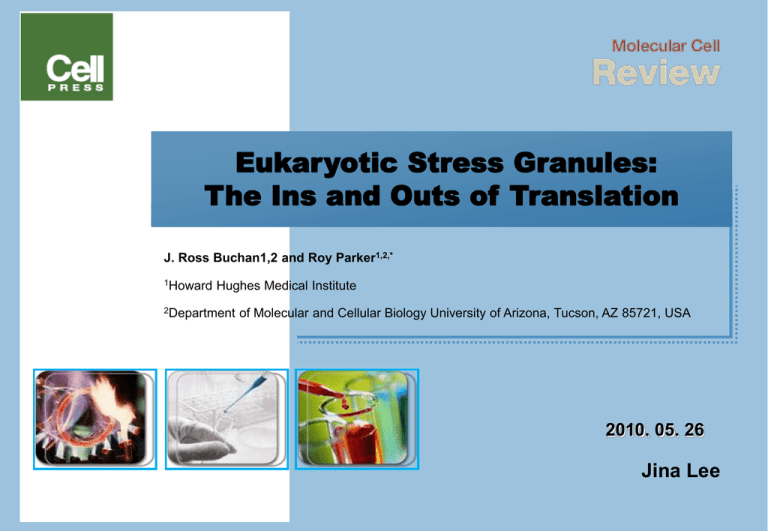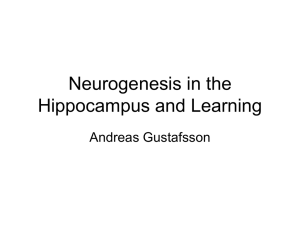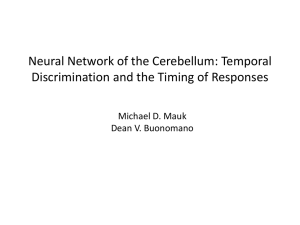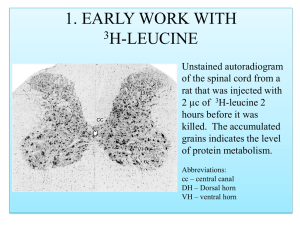Stress Granule and Apoptosis
advertisement

Eukaryotic Stress Granules: The Ins and Outs of Translation J. Ross Buchan1,2 and Roy Parker1,2,* 1Howard Hughes Medical Institute 2Department of Molecular and Cellular Biology University of Arizona, Tucson, AZ 85721, USA 2010. 05. 26 Jina Lee Abstract Stress Inhibition of translation initiation Formation of cytoplasmic RNA-protein complexes (mRNP complex) Stress granule -Nontranslating mRNAs -Translation initiation components -Many additional proteins Introduction Central dogma of molecular biology Initiation -A ribosome attaches to the mRNA Elongation -tRNA brings the corresponding amino acid to each codon Termination -Reading of the final mRNA codon Introduction Translation initiation 43S preinitiation complex (PIC) mRNA activation Scanning AUG recognition Subunit joining Translation elongation Nahum Sonenberg et al. 2009 One What Are Stress Granules? Decreased translation initiation rate Addition of drugs blocking tranalation initiation Stress granule Knockdown of specific initiation factors Overexpression of RNA-binding proteins Stress response Imparing eIF4E function Phosphorylation of eIF2 Limit the formation of a 43S complex Stress granules typically contain… -Poly(A)+ mRNA, 40S ribosomal subunits, eIF4E, eIF4G, eIF4A, eIF4B, Poly(A)-binding protein(PABP), eIF3, eIF2, RNA helicases, translation and stability regulators, cell signaling factors Translation initiation Two Stress Granule Assembly Protein-protein interaction domains ◈Protein modification◈ -Phosphorylation Protein modification Microtubule network -Acetylation -Methylation or the ability to bind methyl groups via tudor domains. Stress granule assembly ◈Protein-protein interaction domains present on numerous RNA-binding proteins◈ -Dimerization : G3BP -QN-rich prion-like domain self-aggregation promote stress granule assembly glutamine/asparagine-rich domain TIA-1, TIA-R contain conserved QN-rich domain -Heat-shock proteins disassemble prion aggregates inhibition stress granule formation Two Stress Granule Assembly ◈Microtubule network◈ -Dynein : Stress granule assembly Kinesin : Stress granule disassembly -Microtubule disruption Kinesin Dynein stress granule assembly defects impaired mRNP transport -eIF3 is required for stress granule formation. • Overexpression or depletion of many factors Stress granule components likely interact in multiple and stress-specific manners • Most factors localize very transiently • Stress granule size and shape varies over time • Assembly factors important under one stress condition Arsenite TIA-1 facilitate stress granule assembly but not in response to other stresses Disassembly of Stress Granule Three Dissociation of the interactions creating the larger aggregate Degrading the stress granule mRNA pool Stress granule disassembly Removal of mRNAs from stress granules by entry into polysomes ◈ RNA-binding proteins Staufen knockdown Grb7 FAK stress granule formation weaken interactions with other stress granule components Grb7-ⓟ Complex TIA-R : translational repressor autoregulatory overexpression and knokdown stress granule formation. loops Cellular conditions Overall concentration Consequence of altered regulation of other stress granule assembly factors Four Stress Granule Function Why do mRNPs aggregate into stress granules? ●Reduce the concentration of those molecules in the cytosol Decrease of global translation •Numerous stress granule components are translational repressors altering the interactions and rates of biochemical reactions Stress Stress RACK protein MTK1 kinase activity Affects whether cells sequestration alteration enter apoptosis granule Stabilize mRNAs •Stress responses inhibit mRNA adenylation mRNA degradation ●Higher local concentration of components in stress granules increase the rates of mRNP assembly or remodeling driven by these factors Five Stress Granule and Apoptosis Stress granule Apoptosis Stress is too extreme and the cell is unable to recover. ● Stress granule harbor several apoptosis regulatory factors. apoptosis-inducing stress Modest stress MTK1 and RACK1 activation RACK1 sequestion apoptosis Do not apoptosis Five Stress Granule and Apoptosis ● Apoptosis regulation may link and directly impact upon mRNP regulation. Ribosomal S6 kinase 2(RSK2) and FAST kinase bind QN-rich domain of TIA-1 Antiapoptotic factor Localize in stress granules - TIA-1-promoted apoptosis via phosphorylation - Impair mRNA binding QN-rich domain activity stress granule localization or assembly In summary, the role of stress granules in controlling apoptosis could be to sequester and nullify apoptosis-promoting factors and simultaneously link appropriate mRNP regulation to this decision process. Summary 1. Stress response inhibits 5. Stress granule reveal a dynamic cycle of distinct biochemical and compartmentalized mRNPs in cytosol translation initiation and leads to the formation of cytoplasmic RNAprotein complexes. 2. Stress granules contain Stress granule nontranslating mRNAs, translation initiation components, and many additional proteins. 4. Stress granules have been linked to apoptosis and nuclear processes. 3. Stress granules have been proposed to affect mRNA translation and stability. Thank you~!!







